Charles E W Bean, Diaries, AWM38 3DRL 606/248/1 - 1917 - 1931 - Part 5
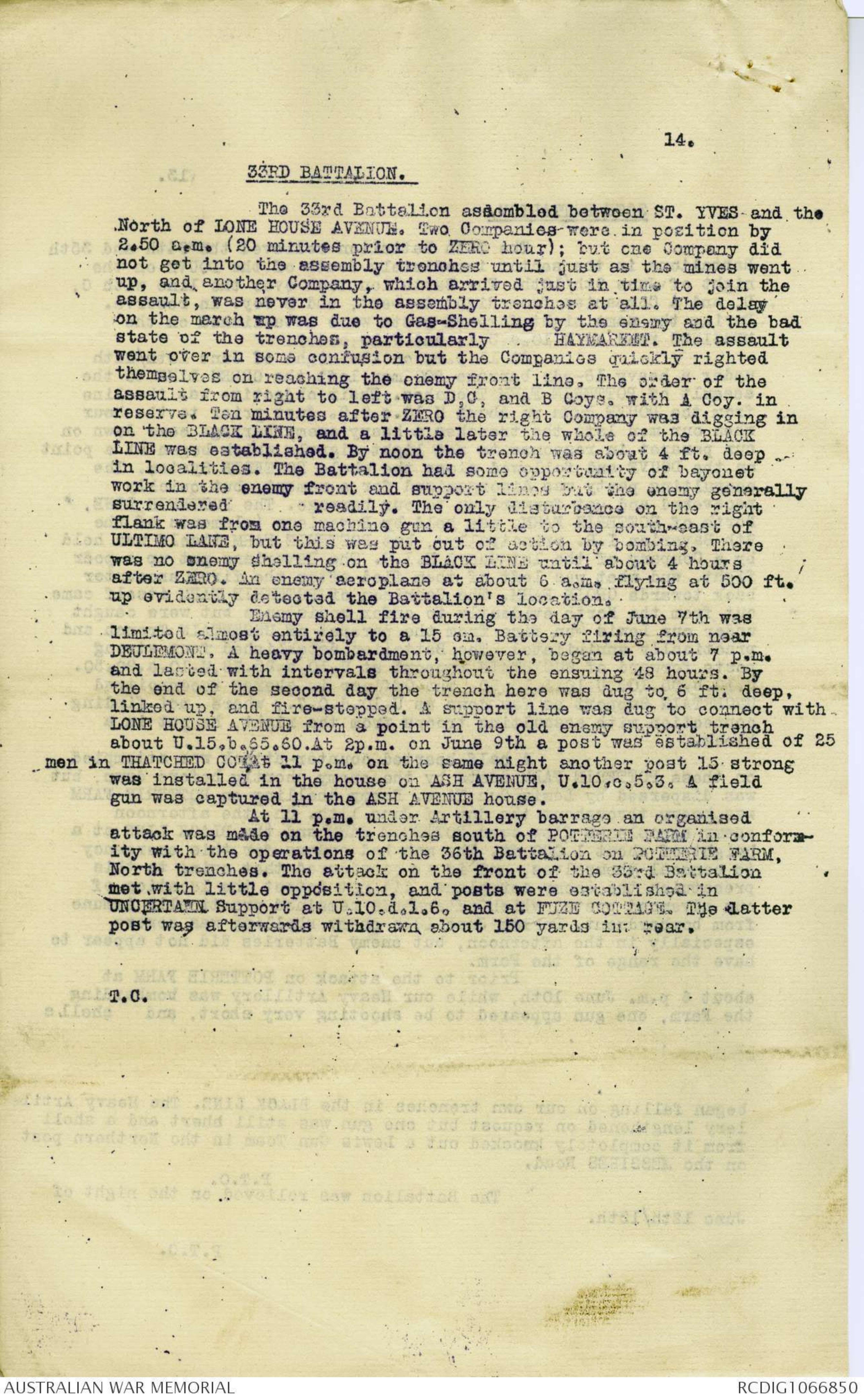
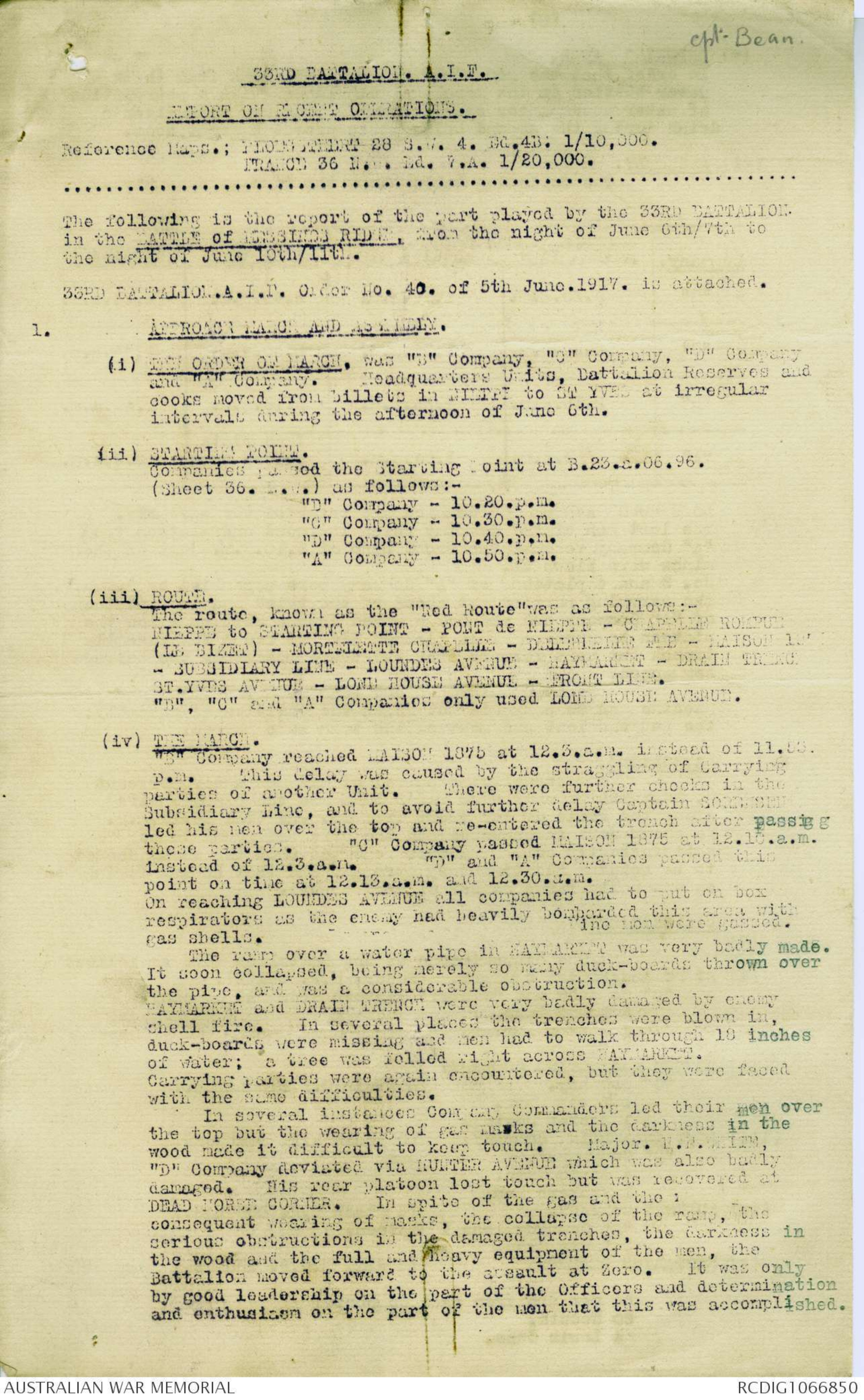
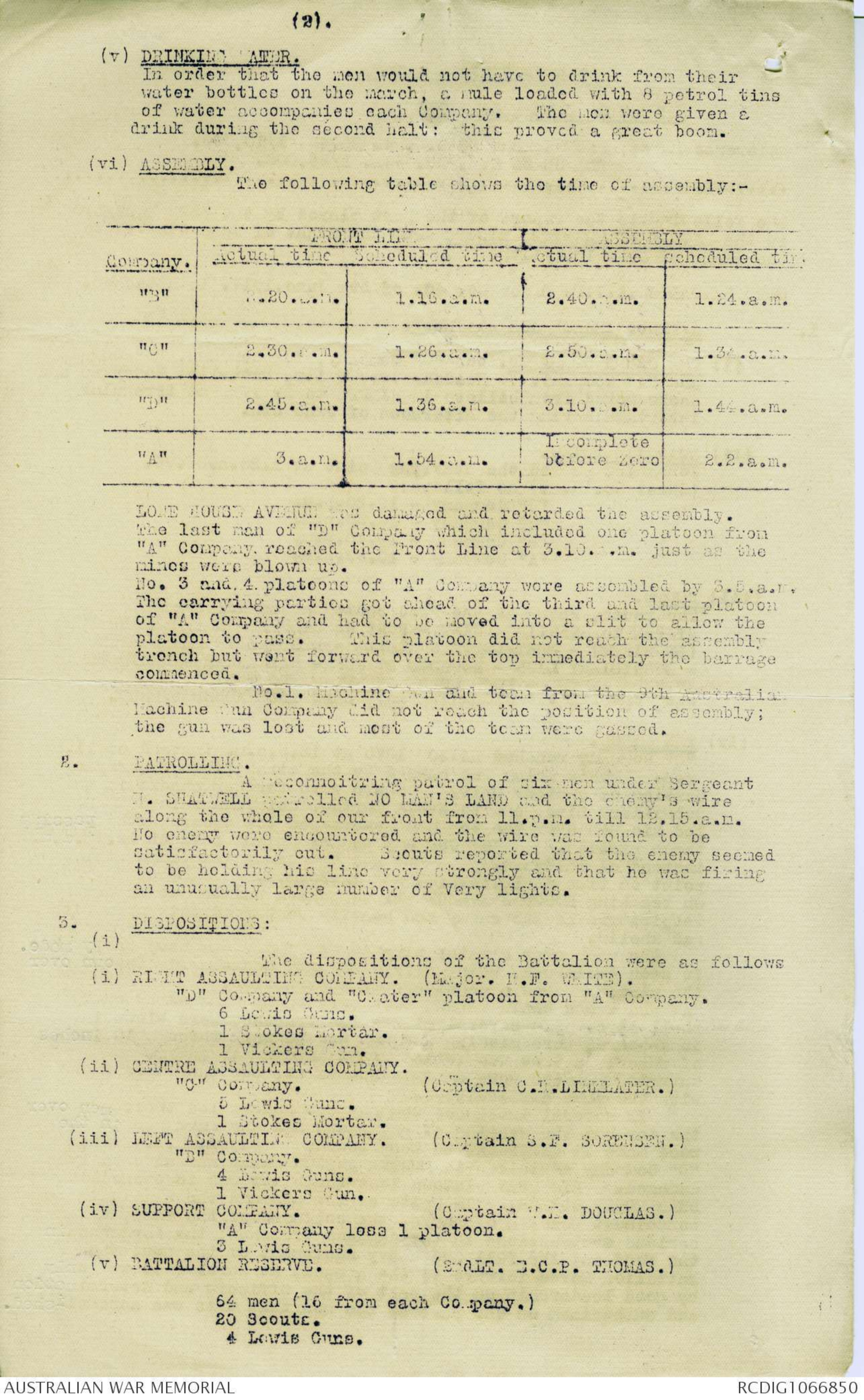

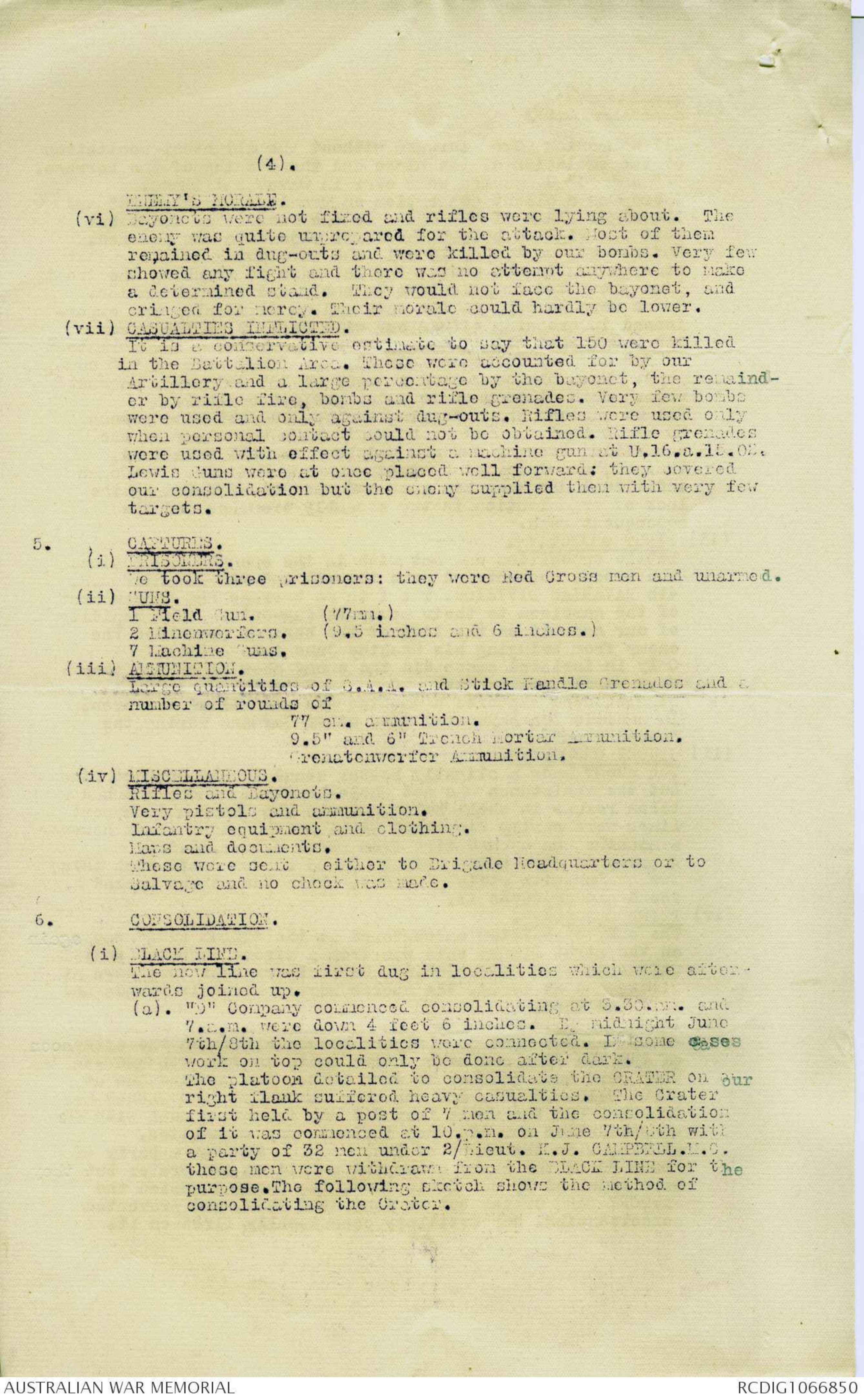
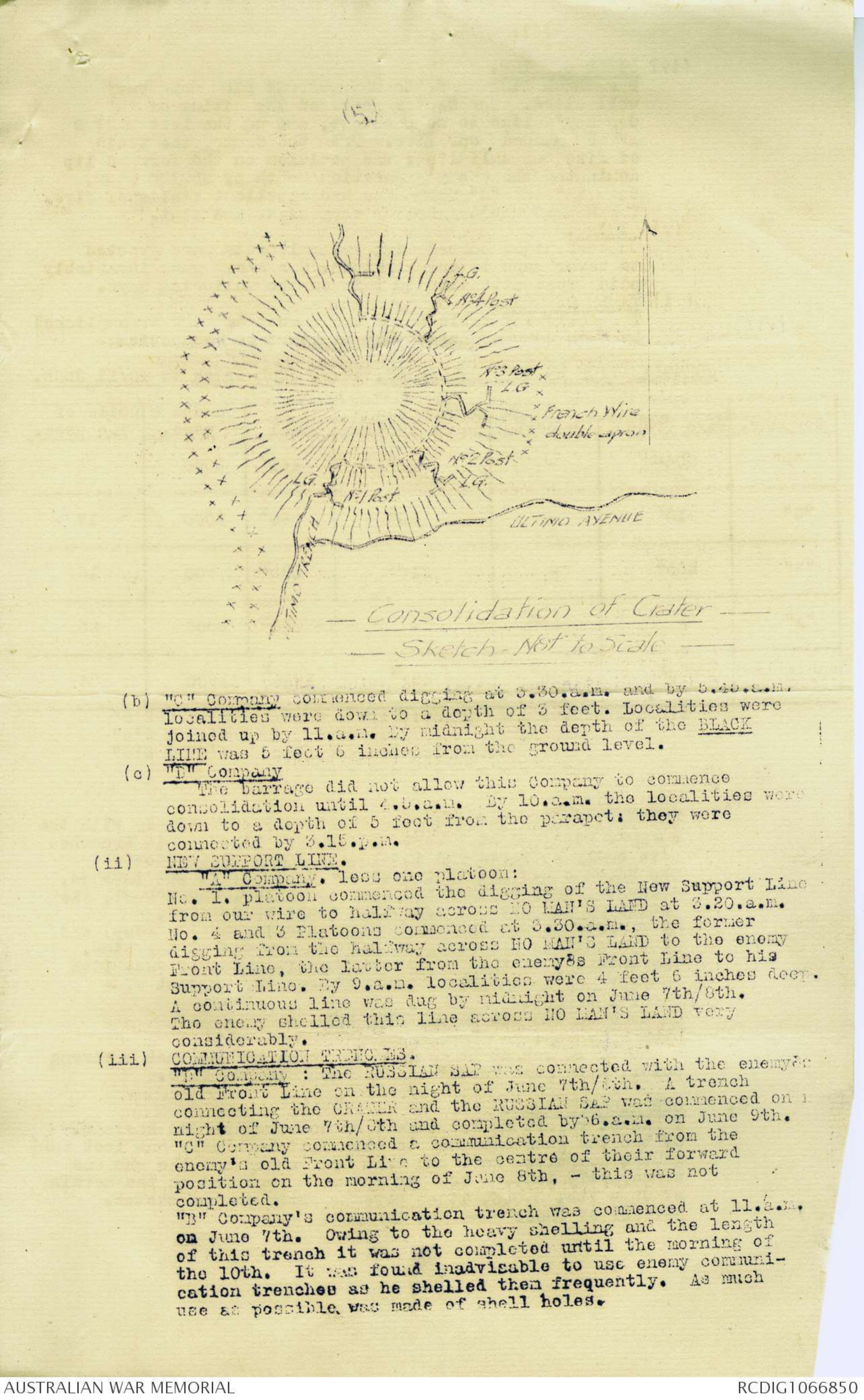
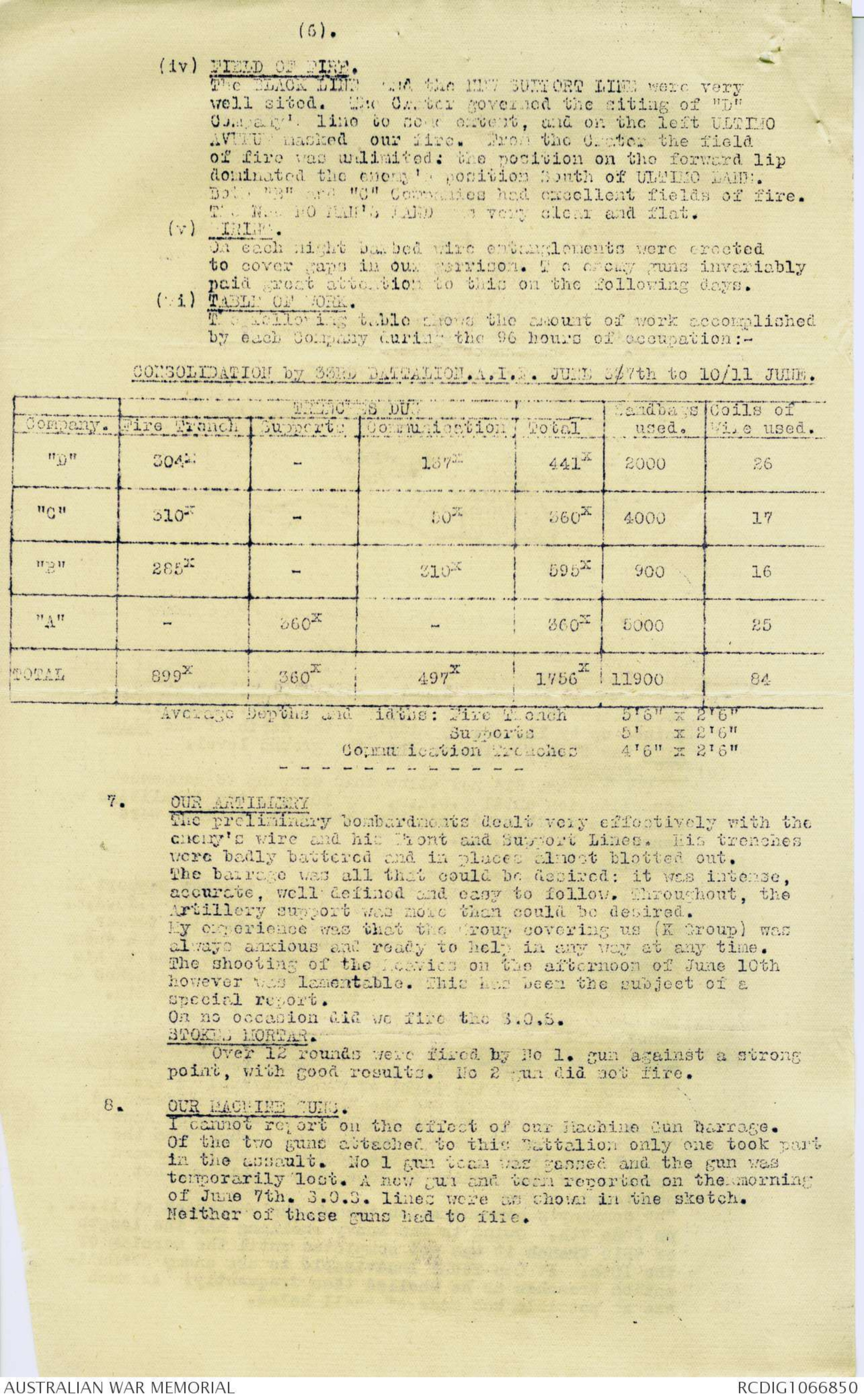
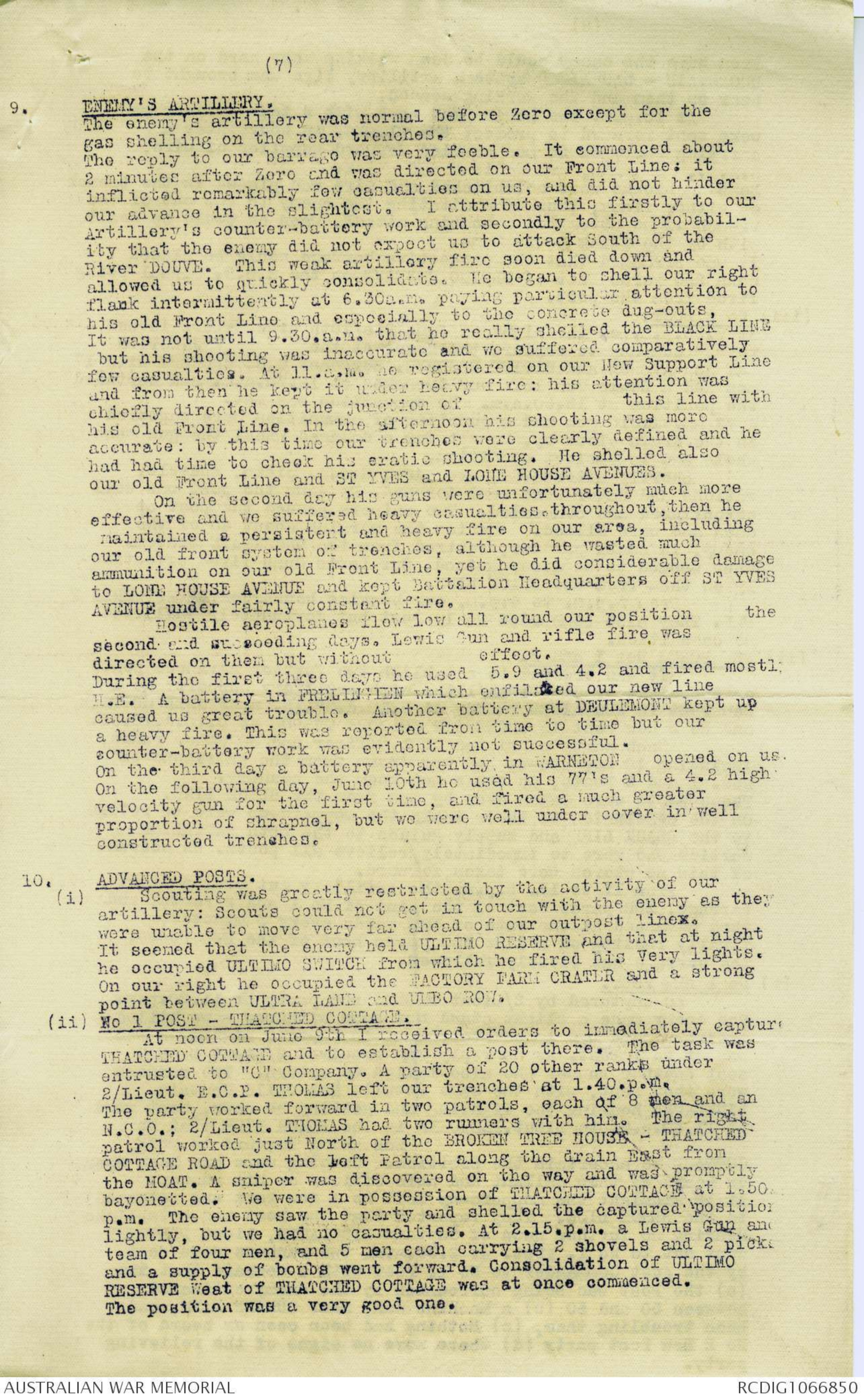
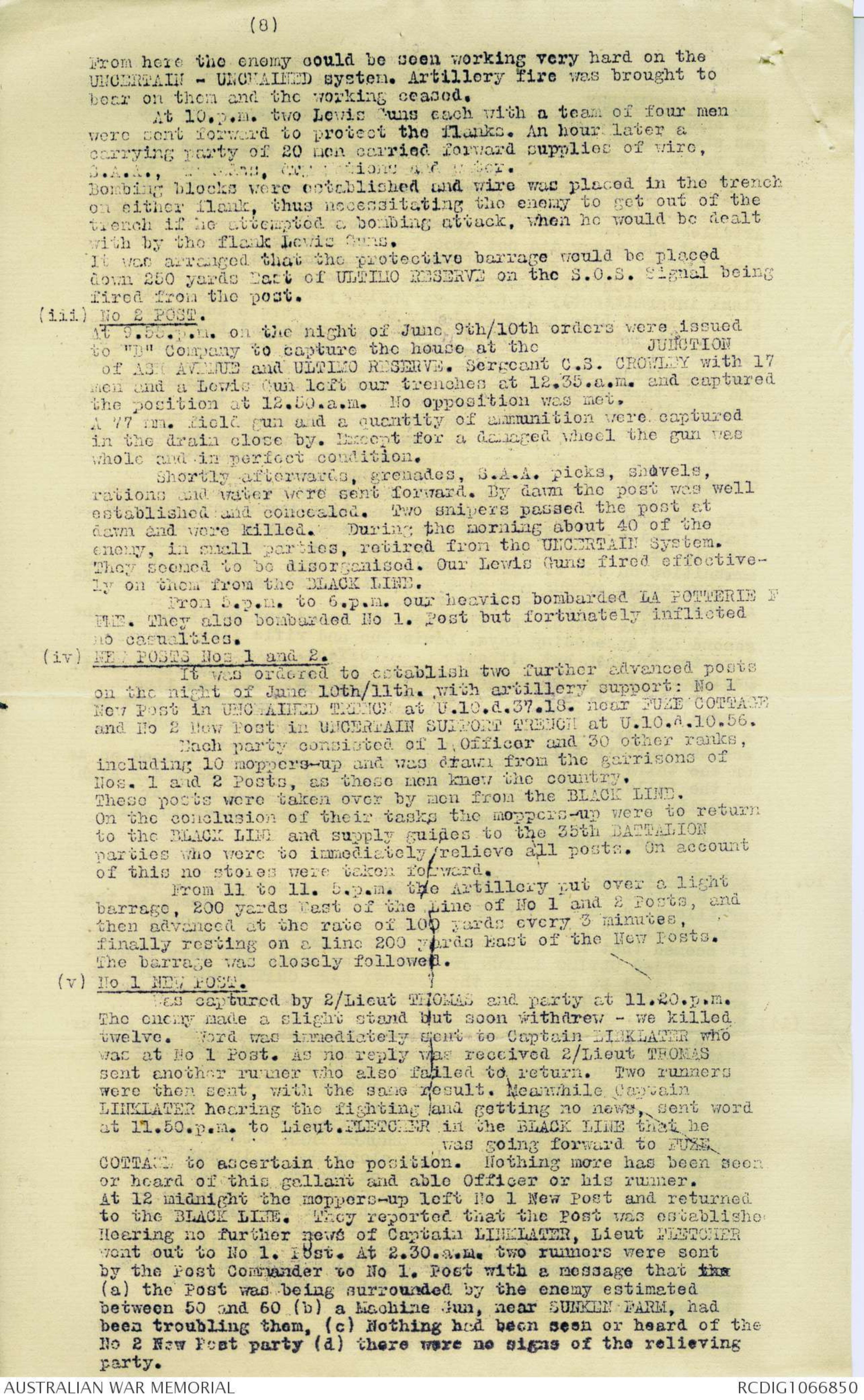
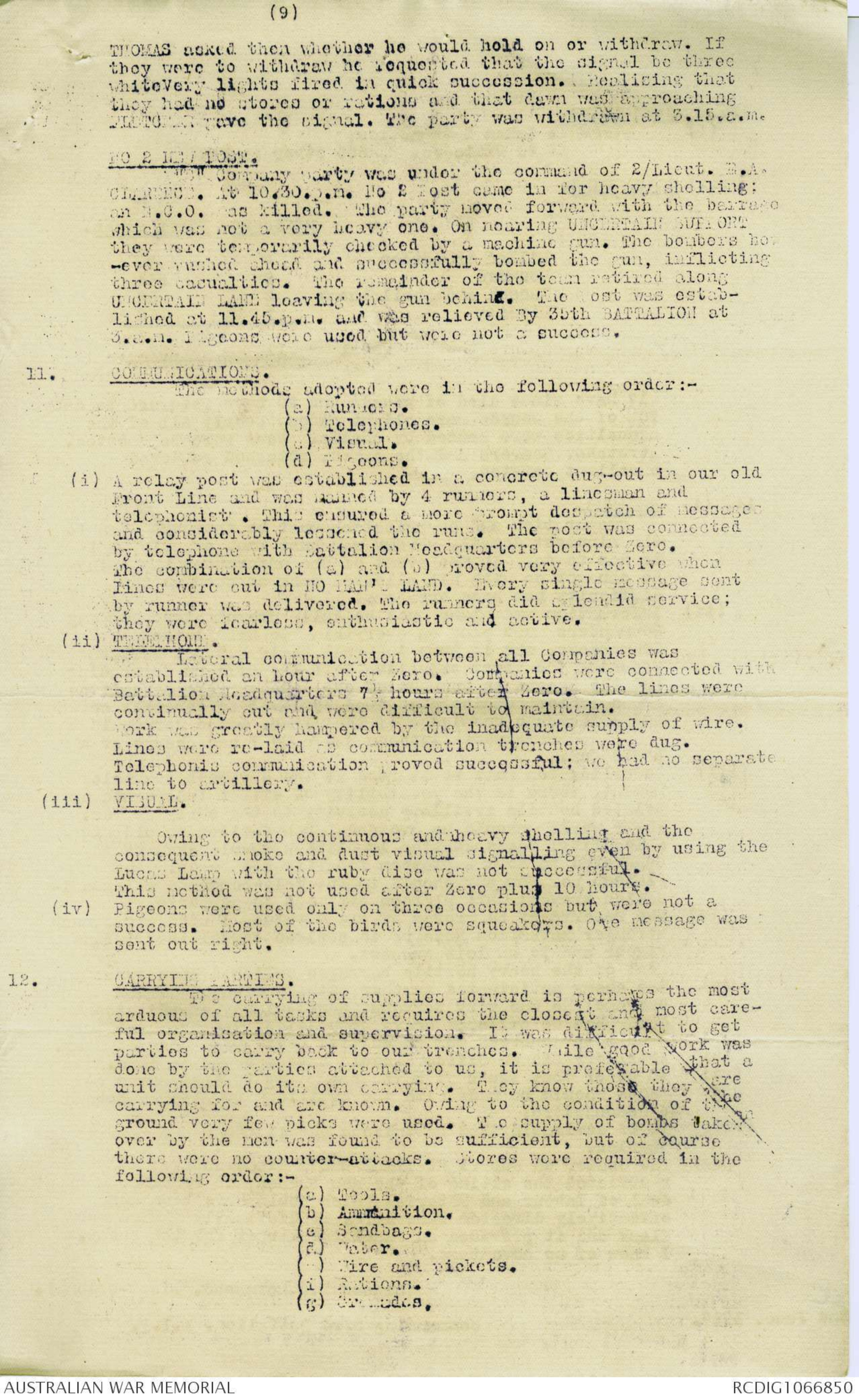
14.
33RD BATTALION.
The 33rd Battalion assembled between St. YVES and the
North of LONE HOUSE AVENUE. Two Companies were in position by
2.50 a.m. (20 minutes prior to ZERO hour); but one Company did
not get into the assembly trenches until just as the mines went
up, and another Company, which arrived just in time to join the
assault, was never in the assembly trenches at all. The delay
on the march up was due to Gas-Shelling by the enemy and the bad
state of the trenches, particularly HAYMARKET. The assault
went over in some confusion but the Companies quickly righted
themselves on reaching the enemy front line. The order of the
assault from right to left was D, C, and B Coys. with A Coy. in
reserve. Ten minutes after ZERO the right Company was digging in
on the BLACK LINE, and a little later the whole of the BLACK
LINE was established. By noon the trench was about 4 ft. deep
in localities. The Battalion has some opportunity of bayonet
work in the enemy front and support lines but the enemy generally
surrendered readily. The only disturbance on the right
flank was from one machine gun a little to the south-east of
ULTIMO LANE, but this was put out of action by bombing. There
was no enemy shelling on the BLACK LINE until about 4 hours
after ZERO. An enemy aeroplane at about 6 a.m. flying at 500 ft.
up evidently detected the Battalion's location.
Enemy shell fire during the day of June 7th was
limited almost entirely to a 15 cm. Battery firing from near
DEULEMONT, A heavy bombardment, however, began at about 7 p.m.
and lasted with intervals throughout the ensuing 48 hours. By
the end of the second day the trench here was dug to 6 ft. deep,
linked up, and fire-stepped. A support line was dug to connect with
LONE HOUSE AVENUE from a point in the old enemy support trench
about U.15.b.65.60.At 2p.m. on June 9th a post was established of 25
men in THATCHED COT, at 11p.m. on the same night another post 15 strong
was installed in the house on ASH AVENUE, U.10.c.5.3. A field
gun was captured in the ASH AVENUE house.
At 11 p.m. under Artillery barrage an organised
attack was made on the trenches south of POTTERIE FARM in conformity
with the operations of the 36th Battalion on POTTERIE FARM,
North trenches. The attack on the front of the 33rd Battalion
met with little opposition, and posts were established in
UNCERTAIN Support at U.10.d.1.6. and at FUZE COTTAGE. The latter
post was afterwards withdrawn about 150 yards in rear.
T.C.
[*Cpt. Bean.*]
33RD BATTALTION. A.I.F.
REPORT OF RECENT OPERATIONS.
Reference Maps.; PLOEGSTEERT 28. S.W.4. Bd.4B. 1/10, 000.
FRANCE 36 N.[[?]]. Bd.7.A. 1/20,000.
The following is the report of the part played by the 33RD BATTALION
in the BATTLE OF MESSINES RIDGE, from the night of June 6th / 7th to
the night of June 10th/11th.
33RD BATTALION.A.I.F. Order No. 40. of 5th June. 1917. is attached.
- APPROACH MARCH AND ASSEMBLY.
(i) THE ORDER OF MARCH. was "B" Company, "C" Company, "D" Company
and "A" Company. Headquarters Units, Battalion Reserves and
cooks moved from billets in NIEPPE to ST YVES at irregular
intervals during the afternoon of June 6th.
(ii) STARTING POINT.
Companies passed the Starting Point at B.23.a.06.96.
(Sheet 36.[[?]].W.) as follows:-
"D" Company - 10.20.p.m
"C" Company - 10.30.p.m
"B" Company - 10.40.p.m
"A" Company - 10.50.p.m
(iii) ROUTE.
The route, known as the "Red Route" was as follows:-
NIEPPE to STARTING POINT - PONT de NIEPPE - CHAPELLE ROMPUE
(LE BIZET) - MORTELETTE CHAPELLE - D[[?]] [[?]] - MAISON 1875
- SUBSIDIARY LINE - LOUNDES AVENUE - HAYMARKET - DRAIN TRENCH
ST. YVES AVENUE - LONE HOUSE AVENUE - FRONT LINE.
"B", "C" and "A" Companies only used LONE HOUSE AVENUE.
(iv) THE MARCH.
"B" Company reached MAISON 187b at 12.3.a.m. instead of 11.55.
p.m. This delay was caused by the straggling of Carrying
parties of another Unit. There were further checks in the
Subsidiary Line, and to avoid further delay Captain SORENSEN
led his men over the top and re-entered the trench after passing
these parties. "C" Company passed MAISON 1875 at 12.10.a.m.
instead of 12.3.a.m. "D" and "A" Companies passed this
point on time at 12.13.a.m. and 12.30.a.m.
On reaching LOUNDES AVENUE all companies had to put on box
respirators as the enemy had heavily bombarded this area with
gas shells. [[?]] Line men were gassed.
The ramp over a water pipe in HAYMARKET was very badly made.
It soon collapsed, being merely so many duck-boards thrown over
the pipe, and was a considerable obstruction.
HAYMARKET and DRAIN TRENCH were very badly damaged by enemy
shell fire. In several places the trenches were blown in,
duck-boards were missing and men had to walk through 18 inches
of water; a tree was felled right across HAYMARKET.
Carrying parties were again encountered, but they were faced
with the same difficulties.
In several instances Company Commanders led their men over
the top but the wearing of gas masks and the darkness in the
wood made it difficult to keep touch. Major. H. F. WHITE,
"D" Company deviated via HUNTER AVENUE which was also very badly
damaged. His rear platoon lost touch but was recovered at
DEAD HORSE CORNER. In spite of the gas and the;
consequent wearing of masks, the collapse of the ramp, the
serious obstructions in the damaged trenches, the darkness in
the wood and the full and heavy equipment of the men, the
Battalion moved forward to the assault at Zero. It was only
by good leadership on the part of the Officers and determination
and enthusiasm on the part of the men that this was accomplished.
(2).
(V) Drinking Water.
In order that the men would not have to drink from their
water bottles on the march, a mule loaded with 8 petrol tins
of water accompanied each Company. The men were given a
drink during the second halt: this proved a great boom:-
(vi) ASSEMBLY.
The following table shows the time of assembly:-
|
FRONT LINE |
ASSEMBLY |
|||
|
COMPANY |
Actual Time |
Scheduled Time |
Actual Time |
Scheduled Time |
|
“B” |
2.20.a.m. |
1.16.a.m. |
2.40.a.m. |
1.24.a.m. |
|
“C” |
2.30.a.m. |
1.26.a.m. |
2.50.a.m. |
1.34.a.m. |
|
“D” |
2.45.a.m. |
1.36.a.m. |
3.10.a.m. |
1.44.a.m. |
|
“A” |
3.a.m. |
1.54.a.m. |
Incomplete before Zero |
2.2.a.m. |
LONE HOUSE AVENUE was damaged and retarded the assembly.
The last man of "D" Company which included one platoon from
"A" Company reached the Front Line at 3.10.a.m. just as the
mines were blown up.
No. 3 and 4. platoons of "A" Company were assembled by 3.5.a.m.
The carrying parties got ahead of the third and last platoon
of "A" Company and had to be moved into a slit to allow the
platoon to pass. This platoon did not reach the assembly
trench but went forward over top immediately the barrage
commenced.
No.1. Machine Gun and team from the 9th Australian
Machine Gun Company did not reach the position of assembly;
the gun was lost and most of the team were gassed.
2. PATROLLING.
A reconnoitring patrol of six men under sergeant
H. SHATWELL patrolled NO MAN'S LAND and the enemy's wire
along the whole of our front from 11.p.m. till 12.15.a.m.
No enemy were encountered and the wire was found to be
satisfactorily cut. Scouts reported that the enemy seemed
to be holding his line very strongly and that he was firing
an unusually large number of Very lights.
3. DISPOSITIONS:
(i) The dispositions of the Battalion were as follows
(ii) RIGHT ASSAULTING COMPANY. (Major H.F. WHITE).
"D" Company and "Crater" platoon from "A" Company.
6 Lewis Guns.
1 Stokes Mortar.
1 Vickers Gun.
(ii) CENTRE ASSAULTING COMPANY
"C" Company. (Captain C.R. LINKLATER.)
5 Lewis Guns.
1 Stokes Mortar.
(iii) LEFT ASSAULTING COMPANY (Captain S.F. SORENSEN.)
"B" Company.
4 Lewis Guns.
1 Vickers Gun.
(iv) SUPPORT COMPANY (Captain W.H. DOUGLAS.)
"A" Company less 1 platoon.
3 Lewis Guns.
(v) BATTALION RESERVE (2ndLT. E.C.P. THOMAS.)
64 men (16 from each Company.)
20 Scouts.
4 Lewis Guns.
(3).
4. THE ASSAULT.
(i) ACTION AT ZERO.
All companies moved forward without the slightest hesitation
on the explosion of the mines and the opening of the barrage.
“B” and “C” Companies went over in waves and lines.
There was a slight congestion on the left flank of “C” and
the right flank of “B” owing to the restricted front but
this was righted before the first objective was reached.
“B” Company went over in only one wave owing to the
disorganization en route; the lateness in reaching the front
line prevented an effective assembly and reorganisation.
There were no gaps in the wave and no difficulty was experienced
in crossing either our wire or that of the enemy.
Touch was kept with “C” Company on the left. No.4. Platoon
of “A” Company followed closely the first wave of “B” Company
No.5. platoon moved in rear of “B” Company’s second
wave. Both platoons were under perfect control.
No.1 platoon began digging the New Support Line across
NO MAN’S LAND as soon as NO MAN’S LAND was clear of the
assaulting troops. Our men had been so well organised,
trained,and informed by their Company Officers that each
Individual man knew his task and was not affected by the
lack of organisation in the assembly trenches and the
consequent rush.
(ii) FIRST OBJECTIVE.
Little opposition was met with in the enemy'8s Front Line.
The troops encountered were the 4th and 9th BAVARIAN J. R.
4th BAVARIAN DIVISION. The intense barrage had driven most
of the garrison to their concrete dug-outs. The rapidity
of our assault on the lift of the barrage prevented the
enemy from bringing his Machine Guns into action.
Only in isolated cases did the enemy show fight and they
were easily dealt with. One of the Privates, J. CARROLL,
singlehanded captured a machine gun and killed the crew.
In addition he bayoneted five other Germans during the
"mopping up".
(iii) SECOND OBJECTIVE.
The enemy made a slightly better stand in his Support Line
but the resistance was not whole-hearted. Those who had
taken refuge in the holes between the Front and Support
Lines were easily dispensed with. On the right flank however
a Machine Gun opened fire from about U.16.a.15.02.
A party of five under Private JAMES SPENCE dealt with this,
two men with rifle grenades, while the others worked
round and captured it.
(iii) THIRD OBJECTIVE.
The only opposition encountered at the "BLACK LINE" was again
on the right flank : this was from a strong infantry post in
ULTIMO LANE at U.16.c.03.60. Our snipers kept them down at
first, and at 4.a.m. the Stokes Mortar fired 12 rounds and
silenced them.
(iii) LATER STAGES.
Enemy Machine guns and snipers became active on the afternoon
of the 7th June and more active again on June 8th and 9th.
They were much quieter on June 10th. One Machine Gun at
about U.16.c.20.65. and one near FLATTENED FARM caused most
trouble. On the whole they did not interfere much with our
consolidation nor did they inflict many casualties.
At 3.a.n. on the night of June :8th/9th a party of
about 30 of the enemy attempted a raid on our crater but they
were repulsed by our Lewis Guns. The enemy occupied the
FACTORY FARM Crater but we dominated this, and prevented'
consolidation. Our artillery occasionally fired on it.
(4).
(vi) ENEMY'S MORALE.
Bayonets were not fixed and rifles were lying about. The
enemy was quite unprepared for the attack. Most of them
remained in dug-outs and were killed by our bombs. Very few
showed any fight and there was no attempt anywhere to make
a determined stand. They would not face the bayonet, and
cringed for mercy. Their morale could hardly be lower.
(vii) CASUALTIES INFLICTED.
It is a conservative estimate to say that 150 were killed
in the Battalion Area. These were accounted for by our
Artillery and a large percentage by the bayonet, the remainder
by rifle fire, bombs and rifle grenades. Very few bombs
were used and only against dug-outs. Rifles were used only
when personal contact could not be obtained. Rifle grenades
were used with effect against a machine gun at U.16.a.15.02.
Lewis Guns were at once placed well forward; they covered
our consolidation but the enemy supplied them with very few
targets.
5. CAPTURES.
(i) PRISONERS.
We took three prisoners: they were Red Cross men and unarmed.
(ii) GUNS.
1 Field Gun. (77mm.)
2 Minenwerfers. (9.5 inches and 6 inches.)
7 Machine Guns.
(iii) AMMUNITION.
Large quantities of S.A.A and Stick Handle Grenades and a
number of rounds of
77 cm. ammunition.
9.5" and 6" Trench Mortar Ammunition.
Grenatenwerfer Ammunition.
(iv) MISCELLANEOUS.
Rifles and Bayonets.
Very pistols and ammunition.
Infantry equipment and clothing.
Maps and documents.
These were sent either to Brigade Headquarters or to
Salvage and no check was made.
6. CONSOLIDATION.
(i) BLACK LINE.
The new line was first dug in localities which were afterwards
joined up.
(a) "D" Company commenced consolidating at 3.30.am. and
7.a.m were down 4 feet 6 inches. By midnight June
7th/8th the localities were connected. In some cases
work on top could only be done after dark.
The platoon detailed to consolidate the CRATER on our
right flank suffered heavy casualties. The Crater
first held by a post of 7 men and the consolidation
of it was commenced at 10.p.m. on June 7th/8th with
a party of 32 men under 2/Lieut. K.J. CAMPBELL.M.C.
these men were withdrawn from the BLACK LINE for the
purpose.The following sketch shows the method of
consolidating the Crater.
(5)
Diagram- see original document
Consolidation of Crater
(b) "C" Company commenced digging at 3.30.a.m. and by 5.45.a.m.
localities were down to a depth of 3 feet. Localities were
joined up by 11.a.m. By midnight the depth of the BLACK
LINE was 5 feet 6 inches from the ground level.
(c) "D" Company
The barrage did not allow this Company to commence
consolidation until 4.5.a.m. By 10.a.m. the localities were
down to a depth of 5 feet from the parapet; they were
connected by 3.15.p.m.
(ii) NEW SUPPORT LINE.
"A" Company. less one platoon:
No. 1 platoon commenced the digging of the New Support Line
from our wire to halfway across NO MAN'S LAND at 3.20.a.m.
No. 4 and 3 Platoons commenced at 3.30.a.m., the former
digging from the halfway across NO MAN'S LAND to the enemy
Front Line, the latter from the enemy's Front Line to his
Support Line. By 9.a.m. localities were 4 feet 6 inches deep.
A continuous line was dug by midnight on June 7th/8th.
The enemy shelled this line across NO MAN'S LAND very
considerably.
(iii) COMMUNICATION TRENCHES.
"D" Company : The RUSSIAN SAP was connected with the enemy's
old Front Line on the night of June 7th/8th. A trench
connecting the CRATER and the RUSSIAN SAP was commenced on
night of June 7th/8th and completed by 6.a.m. on June 9th.
"C" Company commenced a communication trench from the
enemy's old Front Line to the centre of their forward
position on the morning of June 8th, - this was not
completed.
"B" Company's communication trench was commenced at 11.a.m.
on June 7th. Owing to the heavy shelling and the length
of this trench it was not completed until the morning of
the 10th. It was found inadvisable to use enemy communication
trenches as he shelled them frequently. As much
use as possible, was made of shell holes.
(6).
(iv) FIELD OF FIRE.
The Black Line and the NEW SUPPORT LINE were very
well sited. The Crater governed the siting of "D"
Company line to some extent, and on the left ULTIMO
AVENUE masked our fire. From the Crater the field
of fire was unlimited: the position on the forward lip
dominated the enemy's position South of ULTIMO LANE,
Both "B" and "C" Companies had excellent fields of fire.
The New NO MAN'S LAND was very clear and flat.
(v) WIRING.
On each night barbed wire entanglements were created
to cover gaps in our garrison. The enemy guns invariably
paid great attention to this on the following days.
(vi) TABLE OF WORK.
The following table shows the amount of work accomplished
by each Company during the 96 hours of occupation:-
CONSOLIDATION by 33RD BATTALION A.I.F. JUNE 3/7th to 10/11 JUNE.
|
TRENCHES DUG |
Sand Bags Used. |
Coils of Wire Used. |
||||
| Company. | Fire Tranch | Support | Communication | Total | ||
|
"D" |
304x |
- |
137x |
441x |
2000 |
26 |
|
"C" |
310x |
- |
50x |
360x |
4000 |
17 |
|
"B" |
285x |
- |
310x |
595x |
900 |
16 |
|
"A" |
- |
360x |
|
360x |
5000 |
25 |
| TOTAL |
899x |
360x |
497x |
1756x |
11900 |
84 |
Average Depths and Widths: Fire Trench 5'6" x 2'6"
Supports 5' x 2'6"
Communication Trenches 4'6" x 2'6"
7. OUR ARTILLERY
The preliminary bombardments dealt very effectively with the
enemy's wire and his Front and Support Lines. His trenches
were badly battered and in places almost blotted out.
The barrage was all that could be desired: it was intense,
accurate, well defined and easy to follow. Throughout, the
Artillery support was more than could be desired.
My experience was that the group covering us (K Group) was
always anxious and ready to help in any way at any time.
The shooting of the Heavies on the afternoon of June 10th
however was lamentable. This has been the subject of a
Special Report.
On no occasion did we fire the S.O.S.
STOKES MORTAR.
Over 12 rounds were fired by No 1, gun against a strong
point, with good results. No 2. gun did not fire.
8. OUR MACHINE GUNS.
I cannot report on the effect of our Machine Gun barrage.
Of the two guns attached to this Battalion only one took part
in the assault. No 1 gun team was gassed and the gun
was temporarily lost. A new gun and team reported on the morning
of June 7th. S.O.S. lines were as shown in the sketch.
Neither of these guns had to fire.
(7)
9. ENEMY'S ARTILLERY.
The enemy' artillery was normal before Zero except for the
gas shelling on the rear trenches.
The reply to our barrage was very feeble. It commenced about
2 minutes after Zero and was directed on our Front Line: it
inflicted remarkably few casualties on us, and did not hinder
our advance in the slightest. I attribute this firstly to our
Artillery's counter-battery work and secondly to the probability
that the enemy did not expect us to attack South of the
River DOUVE. This weak artillery fire soon died down and
allowed us to quickly consolidate. He began to shell our right
flank intermittently at 6.30a.m. paying particular attention to
his old Front Line and especially to the concrete dug-outs,
It was not until 9.30.a.m. that he really shelled the BLACK LINE
but his shooting was inaccurate and we suffered comparatively
few casualties. At 11.a.m. he registered on our New Support Line
and from then kept it under heavy fire : his attention was
chiefly directed on the junction of this line with
his old Front Line. In the afternoon his shooting was more
accurate : by this time our trenches were clearly defined and he
had had time to check his erratic shooting. He shelled also
our old Front Line and ST YVES and LONE HOUSE AVENUES.
On the second day his guns were unfortunately much more
effective and we suffered heavy casualties throughout, then he
maintained a persistent and heavy fire on our area, including
our old front system of trenches, although he wasted much
ammunition on our old Front Line, yet he did considerable damage
to LONE HOUSE AVENUE and kept Battalion Headquarters off ST YVES
AVENUE under fairly constant fire.
Hostile aeroplanes flew low all round our position the
second and succeeding days. Lewis Gun and rifle fire was
directed on them but without effect.
During the first three days he used 5.9 and 4.2 and fired mostly
H.E. A battery in FRELINGIEN which enfilated our new line
caused us great trouble. Another battery at DEULEMOINT kept up
a heavy fire. This was reported from time to time but our
counter-battery work was evidently not successful.
On the third day a battery apparently at WARNETON opened on us.
On the following day, June 10th he used his 77's and a 4.2 high
velocity gun for the first time, and fired a much greater
proportion of shrapnel, but we were well under cover in well
constructed trenches.
10. ADVANCED POSTS.
(i) Scouting was greatly restricted by the activity of our
artillery : Scouts could not get in touch with the enemy as they
were unable to move very far ahead of our outpost linex.
It seemed that the enemy held ULTIMO RESERVE and that at night
he occupied ULTIMO SWITCH from which he fired his Very lights.
On our right he occupied the FACTORY FARM CRATER and a strong
point between ULTRA LANE and UMBO ROW.
(ii) No 1 POST - THATCHED COTTAGE.
At noon on June 9th I received orders to immediately capture
THATCHED COTTAGE and to establish a post there. The task was
entrusted to "C" Company. A party of 20 other ranks under
2/Lieut. E.C.P. THOMAS left our trenches at 1.40.p.m.
The party worked forward in two patrols, each of 8 men and an
N.C.O.; 2/Lieut. THOMAS had two runners with him. The right
patrol worked just North of the BROKEN TREE HOUSE - THATCHED
COTTAGE ROAD and the left patrol along the drain East from
the MOAT. A sniper was discovered on the way and was promptly
bayonetted. We were in possession of THATCHED COTTAGE at 1.50.
p.m. The enemy saw the party and shelled the captured position
lightly, but we had no casualties. AT 2.15.p.m. a Lewis Gun and
team of four men, and 5 men each carrying 2 shovels and 2 picks
and a supply of bombs went forward. Consolidation of ULTIMO
RESERVE West of THATCHED COTTAGE was at once commenced.
The position was a very good one.
(8)
From here the enemy could be seen working very hard on the
UNCERTAIN - UNCHAINED system. Artillery fire was brought to
bear on them and the working ceased.
At 10.p.m. two Lewis Guns each with a team of four men
were sent forward to protect the flanks. An hour later a
carrying party of 20 men carried forward supplies of wire,
S.A.A., [[?]] [[?]] dry rations and water.
Bombing blocks were established and wire was placed in the trench
on either flank, thus necessitating the enemy to get out of the
trench if he attempted a bombing attack, when he would be dealt
with by the flank Lewis Guns.
It was arranged that the protective barrage would be placed
down 250 yards East of ULTIMO RESERVE on the S.O.S. Signal being
fired from the post.
(iii) No 2 POST.
At 9.55.p.m. on the night of June 9th/10th orders were issued
to "B" Company to capture the house at the JUNCTION
of ASH AVENUE and ULITMO RESERVE. Sergeant C.S. CROWLEY with 17
men and a Lewis Gun left our trenches at 12.35.a.m. and captured
the position at 12.50.a.m. No opposition was met.
A 77 mm field gun and a quantity of ammunition were captured
in the drain close by. Except for a damaged wheel the gun was
whole and in perfect condition.
Shortly afterwards, grenades, S.A.A. picks, shovels,
rations and water were sent forward. By dawn the post was well
established and concealed. Two snipers passed the post at
dawn and were killed. During the morning about 40 of the
enemy, in small parties, retired from the UNCERTAIN System.
They seemed to be disorganised. Our Lewis Guns fired effectively
on them from the BLACK LINE.
From 5.p.m. to 6.p.m our heavies bombarded LA POTTERIE
FARM. they also bombarded No 1 Post but fortunately inflicted
no casualties
(iv) NEW POSTS Nos 1 and 2.
It was ordered to establish two further advance posts
on the night of June 10th/11th. with artillery support: No 1
New Post in UNCHAINED TRENCH at U.10.d.37.18 near FUZE COTTAGE
and No 2 New Post in UNCERTAIN SUPPORT TRENCH at U.10.d.10.56.
Each party consisted of 1 Officer and 30 other ranks,
including 10 moppers-up and was drawn from the garrisons of
Nos. 1 and 2 Posts, as these men knew the country.
These posts were taken over by men from the BLACK LINE.
On the conclusion of their tasks the moppers-up were to return
to the BLACK LINE and supply guides to the 35th BATTALION
parties who were to immediately relieve all posts. On account
of this no stores were taken forward.
From 11 to 11. 5.p.m. the Artillery put over a light
barrage, 200 yards East of the Line of No 1 and 2 Posts, and
then advanced at the rate of 100 yards every 3 minutes,
finally resting on a line 200 yards East of the New Posts.
The barrage was closely followed.
(v) No 1 NEW POST.
Was captured by 2/Lieut THOMAS and party at 11.20.p.m.
The enemy made a slight stand but soon withdrew - we killed
twelve. Word was immediately sent to Captain LINKLATER who
was at No 1 Post. As no reply was received 2/Lieut THOMAS
sent another runner who also failed to return. Two runners
were then sent, with the same result. Meanwhile Captain
LINKLATER hearing the fighting and getting no news, sent word
at 11.50.p.m. to Lieut.FLETCHER in the BLACK LINE that he
was going forward to FUZE
COTTAGE to ascertain the position. Nothing more has been seen
of this gallant and able Officer or his runner.
At 12 midnight the moppers-up left No 1 New Post and returned
to the BLACK LINE. They reported that the Post was established
Hearing no further news of Captain LINKLATER, Lieut FLETCHER
went out to No 1. Post. At 2.30.a.m. two runners were sent
by the Post Commander to No 1. Post with a message the the
(a) the Post was being surrounded by the enemy estimated
between 50 and 60 (b) a Machine Gun, near SUNKEN FARM, had
been troubling them, (c) Nothing had been seen or heard of the
No 2 New Post party (d) there were no signs of the relieving
party.
(9)
THOMAS asked then whether he would hold on or withdraw. If
they were to withdraw he requested that the signal be three
whiteVery lights fired in quick succession. Realising that
they had no stores or rations and that dawn was approaching
FLETCHER gave the signal. The party was withdrawn at 3.15.a.m.
No 2 NEW POST.
"D" Company party were under the command of 2/Lieut. E.A.
CLARENCE. At 10.30.a.m. No 2 Post came in for heavy shelling;
an N.C.O. was killed. The party moved forward with the barrage
which was not a very heavy one. On nearing UNCERTAIN SUPPORT
they were temporarily checked by a machine gun. The bombers however
rushed ahead and successfully bombed the gun, inflicting
three casualties. The remainder of the team retired along
UNCERTAIN LANE leaving the gun behind. The post was established
at 11.45.p.m. and was relieved By 35th BATTALION at
3.a.m. Pigeons were used but were not a success.
11. COMMUNICATIONS.
The methods adopted were in the following order :-
(a) Runners.
(b) Telephone.
(c) Visual.
(d) Pigeons.
(i) A relay post was established in a concrete dug-out in our old
Front Line and was manned by 4 runners, a linesman and
telephonist. This ensured a more prompt despatch of messages
and considerably lessened the runs. The post was connected
by telephone with Battalion Headquarters before Zero.
The combination of (a) and (b) proved very effective when
lines were out in NO MAN'S LAND. Every single message sent
by runner was delivered. The runners did splendid service ;
they were fearless, enthusiastic and active.
(ii) TELEPHONE.
Lateral communication between all Companies was
established a hour after Zero. Companies were connected with
Battalion Headquarters 7½ hours after Zero. The lines were
continually cut and were difficult to maintain.
Work was greatly hampered by the inadequate supply of wire.
Lines were re-laid as communication trenches were dug.
Telephonis communication proved successful; we had no separate
line to artillery.
(iii) VISUAL.
Owing to the continuous and heavy shelling and the
consequent smoke and dust visual signalling even using the
Lucas Lamp with the ruby disc was not successful.
This method was not used after Zero plus 10 hours.
(iv) Pigeons were used only on three occasions but were not a
success. Most of the birds were squeakers. One message was
sent out right.
12. CARRYING PARTIES.
The carrying of supplies forward is perhaps the most
arduous of all tasks and requires the closest and most careful
organisation and supervision. It was difficult to get
parties to carry back to our trenches. While good work was
done by the parties attached to us, it is preferable that a
unit should do its own carrying. They know those they are
carrying for and are known. Owing to the condition of the
ground very few picks were used. The supply of bombs taken
over by the men was found to be sufficient, but of course
there were no counter-attacks. Stores were required in the
following order:-
(a) Tools.
(b) Ammunition.
(c) Sandbags.
(d) Water.
(e) Wire and pickets.
(f) Rations.
(g) Grenades.
 Deb Parkinson
Deb ParkinsonThis transcription item is now locked to you for editing. To release the lock either Save your changes or Cancel.
This lock will be automatically released after 60 minutes of inactivity.